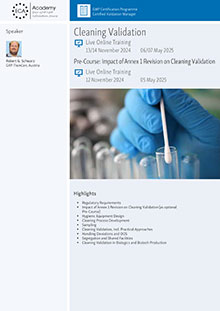MODERN QUALIFICATION - WHAT DOES THAT MEAN?
Pharmaceutical Qualification and Validation requirements came up with the FDA Guideline on Process Validation in 1987. In the EU they also became a requirement with the EU-GMP Guideline from 1989.
At this time the pharmaceutical industry was unsure how to implement these requirements in practice. Especially the qualification documentation regarding Installation Qualification (IQ) and Operational Qualification (OQ) increased - just "to be on the safe side". Although industry guidelines including templates coming up were helpful, the amount of documentation still was tremendous. Even the implementation of risk assessments and of Good Engineering Practice (GEP) into qualification activities didn´t help to make it really slimmer. Qualification activities even took more time than before. Moreover, QA became involved more deeply, but without a strong focus on the safety of patients.
The publication of ASTM E 2500 in 2007 as well as the revision of the FDA Process Validation Guideline from 1987 changed things in the US. The manufacturing process increasingly moved into the focus. Further, the terms IQ, OQ were not mentioned any more. In the FDA Guideline Design Qualification (DQ) is not even mentioned. However, qualification is still a pre-requisite for process validation.
With the revision of Annex 15, which came into force in October 2015, qualification activities have also become more flexible in the EU. The classical DQ/IQ/OO/PQ-steps are only a "could requirement". Also, now there are alternatives possible.
But what can these alternatives look like? How can industry move to fast-track projects during qualification? And how can qualification activities be integrated into process validation activities?

Recommendation
Wednesday, 7 May 2025 9 .00 - 12.30 h
Post-Course: Impact of Annex 1 Revision on Cleaning Validation - Live Online Training
To provide support with regard to these questions the ECA´s Validation Interest Group has founded a task force. This task force is currently working on a guide on modern qualification. From their perspective the essential points for modern qualification are:
- Risk Management (incl. Quality Risk Assessment)
- User Requirement Specifications (based on Risk Management principles)
- Design Review and Design Qualification
- Re-use of inspection and tests based on Good Engineering Practice (including possibly IQ and OQ) rather than retesting
- Performance qualification (incl. performance testing of manufacturing systems, utilities and facility systems
- Integration of qualification activities in process validation.
For the task force one key to success for modern qualification - and so far also for fast-track projects - is the relationship between customers and suppliers. Therefore, the new guide is entitled "Modern Qualification - a guide to effective qualification based on Customer-Supplier Partnership".
This guide explains what the activities are for customers, what they are for suppliers and what both have to do to successfully realize a fast-track qualification project. Alike in the GAMP®-Guide it also comprises a lot of templates which are really helpful for both the pharmaceutical industry and for suppliers.
Author:
Sven Pommeranz
... is Operations Director and organises and conducts courses and conferences on behalf of the ECA Academy in the area validation.



